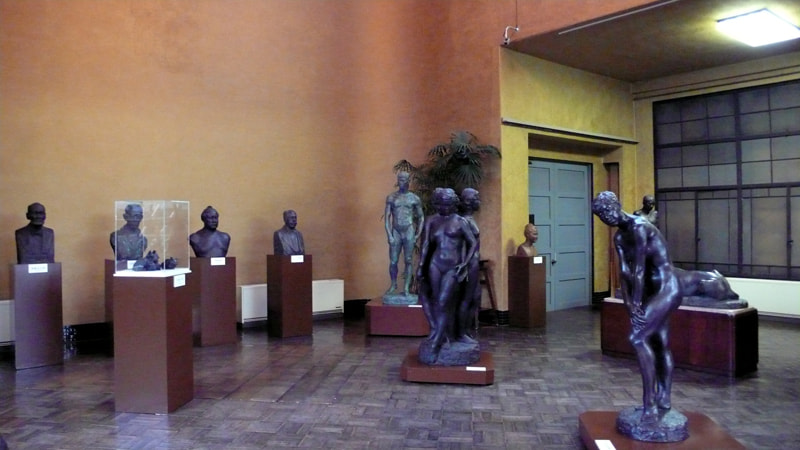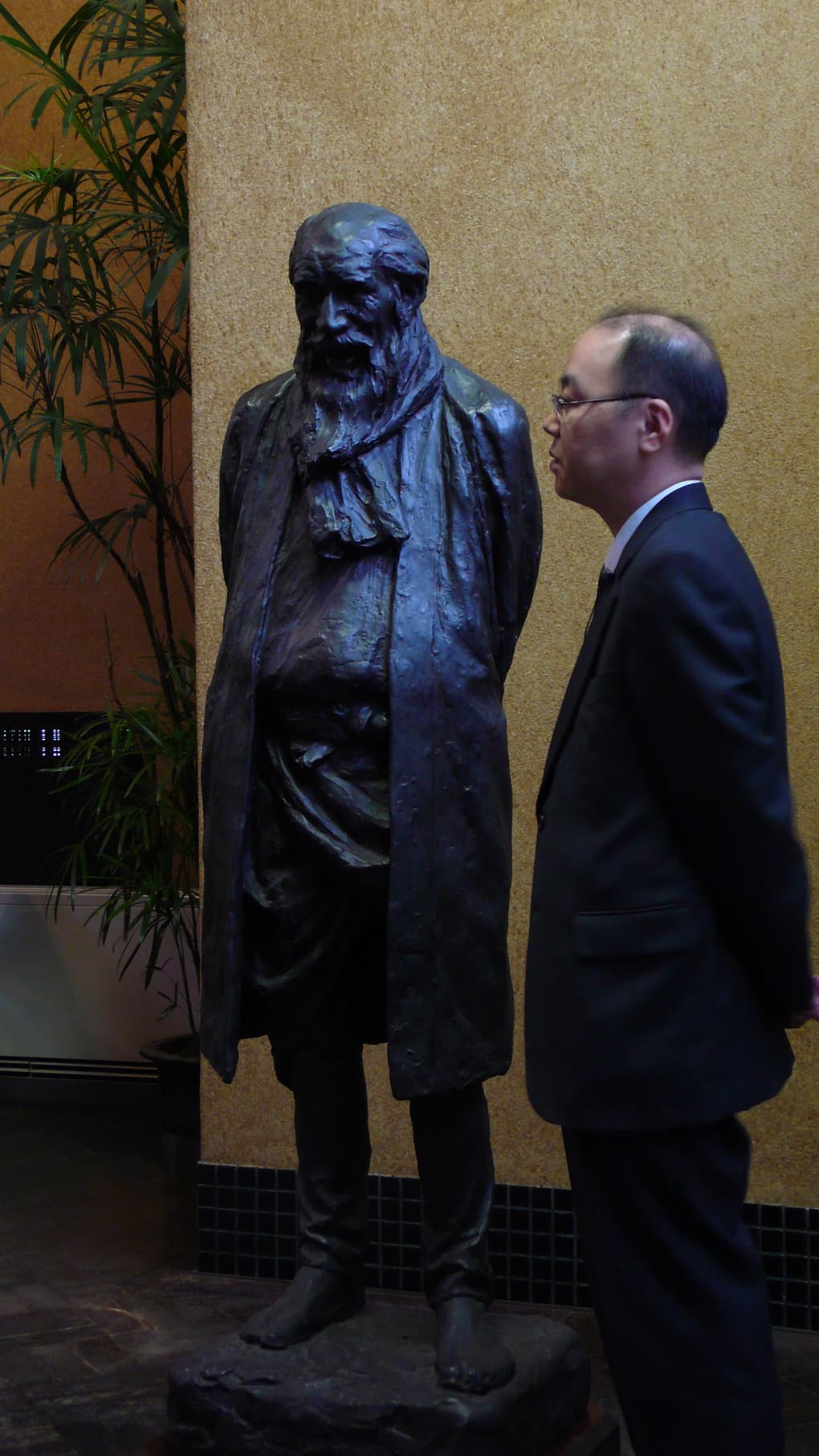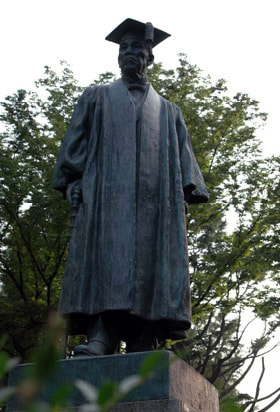

Mansuke Murayama, a researcher of the Asakura Museum of Sculpture.
Murayama : Here is the studio of the Asakura Museum of Sculpture that was completed in 1935. This building is now called "Asakura Museum of Sculpture," but it was once Fumio Asakura's house and a sculpture school called "Asakura Choso Juku." Actually, there are many sculptures created by Asakura. All of these are bronze statues. The first step of creating these statues is to make clay models. At this point, their shapes are completed, but the clay models break easily. So you need to make plaster molds of them, and create positive plaster casts. Then, you make new molds based on the positive casts, and cast them into bronze. In this final step, you make casting molds, and pour liquid bronze into the molds. These bronze statues were created in this way. I briefly explained the process, but the actual process is very complicated consisting of about 150 steps, in which, for example, plaster workers and casting technicians work together to complete statues.
This is "Hakamori," or the grave keeper, one of Fumio Asakura's masterpieces. Hakamori was created in 1910, which was exhibited at "Bunten," or the fourth Ministry of Education's art exhibition in the same year and received the grand prize. Although this piece was made when he was relatively young, it has a significant meaning among all of his works. It was a real turning point in his art. He graduated from an art school in 1907, and made his debut at the second Bunten in 1908. If you look at his early works which were created during several years after his graduation, for example, "Shinka," or evolution, displayed here, which was created as his graduation work, "Yami," or darkness, which was his debut work and not preserved, and "Yamakara Kita Otoko," or a man from a mountain, which is owned by the National Museum of Modern Art, Tokyo, at Takebashi, you can understand that these works are very subjective and have literary tiles. Specifically speaking, he first came up with subjects in theory, and then made actual pieces in line with the subjects.
Q: What is the difference between modeling and carving?
It is a matter of techniques. In some cases, techniques and materials are entirely different. Generally, "Chokoku," or carving, and "Choso," or modeling, are collectively called sculpture. Although other terms, such as three-dimensional work and various new terms, might be used nowadays, they, on the whole, are more often called sculpture. However, the term "modeling" has definitely been used in the art history. Carving is a technique to engrave wood or stone with, for example, a graver or chisel. So when you make carving, you carve an image out of wood or a block of something. On the other hand, for example a human body, the first step to make Choso is to build a framework. Then, you wind a palm rope around the framework. This palm rope is use as a slip resistance material, on which clay is applied. When you feel too much clay is applied, you can remove it by hands or a pallet and reapplied it if necessary.(continued in the right column)
Nowadays, although there are a variety of terms, such as Chokoku and Choso, all of these terms are translated terms. There are many translated terms not only in the field of fine arts but also in various fields of cultures in 1894. The term "Bijutsu," or fine arts, is also a translated term, and so do the term Chokoku. So the term Chokoku had been used. However, Seigai Omura, who was a teacher of Asakura and taught art history at Tokyo Bijutsu Gakko (the predecessor of the present Tokyo University of the Arts), wrote "Choso-ron," or an essay on modeling, in which he argued that, although art historians call it Chokoku, the term Choso is better because those clay works have both elements, carving and modeling. Asakura was instructed by Omura, and therefore was conscious of creating Choso other than Chokoku. Asakura was very proud of being "Choso-ka," or Choso artist, and created Choso while bearing the term Choso in mind throughout his life. This is the reason why this museum is called Asakura Museum of Sculpture (formerly called Asakura Choso Juku).
Q: Did Asakura also create carvings?
Asakura also had carving skills. He had studied at Tokyo Bijutsu Gakko in 1900s. Sculpture students at that time had to study wood carving as their compulsory subjects even though they selected Choso. The teacher of wood carving was Koun Takamura, a famous sculptor. Asakura thoroughly learned wood carving from Koun, and then, or at the same time, created those clay works. A piece of wood carving created by Asakura has been preserved. So he had skills to carve small pieces of material, such as a small stone.

The Statue of Sigenobu Okuma in Waseda University.
Although details are unknown, it is sure that Asakura had formed a close relationship with Okuma during his lifetime. It seems that Okuma had a great influence on Asakura's character-building and thought. Probably due to the relationship, Asakura created three statues of Okuma. Two of them now exist. Although the first statue does not exist, the first one wearing formal clothes was placed at Shiba Park. Another one has been placed in the Diet Building. This is a statue wearing a frock coat.
It has been a last statue of Okuma placed at Waseda University. This is a reproduction of its master model. The master model is a plaster model. It is difficult to preserve the model if it is displayed. So its reproduction made of another material has been displayed. I think this is the most famous statue of Okuma. This statue is a portrait sculpture created by Asakura. Generally, people use the term "bronze statue," but, in the field of art history, the term "portrait sculpture" is used.
Asakura created many portrait sculptures. It is said that he created about 500 to 600 portrait sculptures, most of which were commissioned. The statue of Okuma is one of them. Asakura had great skills, so it was marvelously created. However, there are two types of sculptures, artistic sculptures that he creatively made and other sculptures that he just made because they were commissioned. In this sense, the statue of Okuma is one of the most excellent portrait sculptures, which has profound expressions. It is not just a copy of a form or facial expressions, but a pure representation of an object or person, which I think is one of difficult aspects of making sculptures. A portrait sculpture of a living person, in particular, has to contain his/her past and future in it. For example, a two-hour play in which an actor acts decades of a person's life is produced through some kind of abstraction. However, a sculptor should create a sculpture that contains a model's past, present and future. It is not just a building up of a form. In this sense, the statue of Okuma is a sculpture that embodies the above explanations. Moreover, this is not just a standing statue. There were many difficulties when it was created. Please look at the balance and the pose. It does not just stand straight, but is slightly twisted making movements throughout the body. Asakura created this statue while considering how the body moved and stood behind the coat. This is one of the most successful examples of such a creative process. I think four statues displayed here were also successfully created following such a creative process. I think, in particular,
the statue of Danjuro, and his father's and mother's statues of Asakura which are placed on the opposite side are his masterpieces.
In most cases, sizes of sculptures are decided according to clients' requests. Generally, life-size sculptures are created, so small sculptures are exceptional. In this sense, Asakura had created sculptures while shouldering old Japan though he was called a sculptor of the modern age. This statue's size is "Ichijo Nishaku" in an archaic Japanese unit of length, which is approximately equal to 3.6 meters. Sculptures larger than this size were made in the sizes ranging from "Ichijo Rokushaku" to "Ichijo Hasshaku," which is the size of "Joroku-butsu," or Buddhist statue approximately 4.85 meters high. The term has been used by sculptors of Buddhist statues. Although Asakura learned sculpture from Koun Takamura, a woodcarver, and opened up the new fields of modern sculpture and Choso, he assumed those old things at the same time and decided the size of the statue. I think when Waseda University or an association of Shigenobu Okuma ordered the statue, he might decide the size in the following conversation: "How many 'Shaku,' or meters, high is appropriate for the pedestal in the grounds? I think 'Ichijo Nishaku' is appropriate for the size of the statue on it - Ichijo Nishaku from top to toe." (continued in the next page)

Mansuke Murayama, a researcher of the Asakura Museum of Sculpture.












